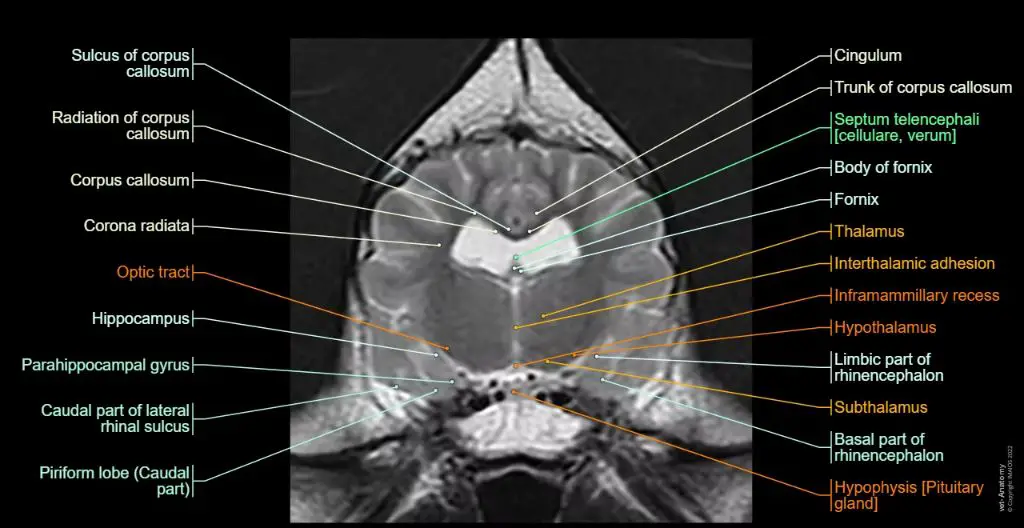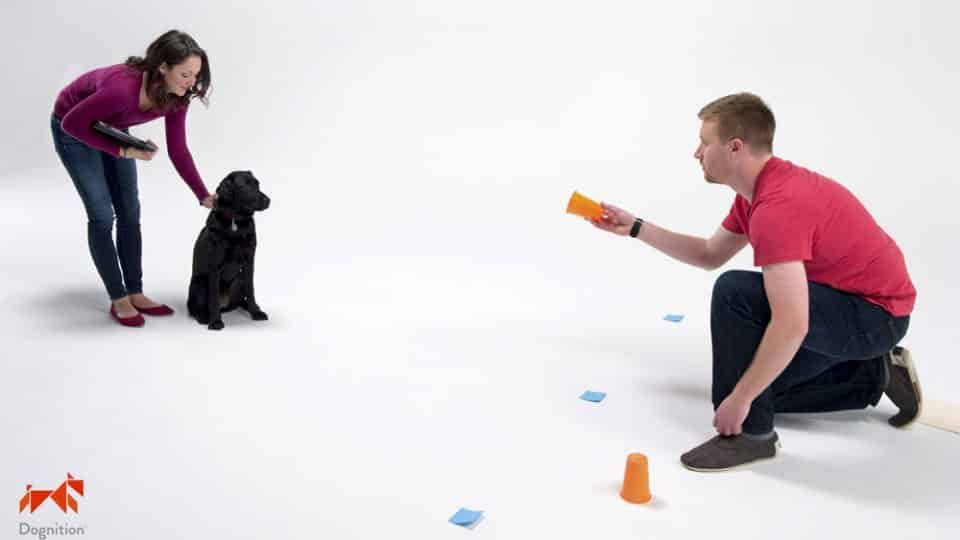Introduction
Did you know that different breeds of dogs can have drastically different brain sizes, even when their overall body size is similar? The brains of dogs come in a wide range of shapes and sizes. While we often joke about dogs having “walnut-sized” brains, the truth is much more complex and fascinating.
In this article, we’ll explore how and why the size of a dog’s brain varies between breeds. We’ll look at how brain size correlates with trainability, lifespan, health, and more. You may be surprised to learn just how large some dogs’ brains are! We’ll also touch on the history of understanding dog brain anatomy and what insights modern science has given us.
By the end, you’ll have a deeper appreciation for the impact of brain size on our canine companions. Let’s dive in!
Why Brain Size Matters
Research shows that there is a correlation between brain size and intelligence and cognitive ability in dogs. Dogs with larger brains tend to have greater intelligence and ability to process information and learn commands compared to dogs with smaller brains [1]. This is because larger brains have more surface area and cortical folding, allowing them to process more sensory information from sight, smell, hearing, and touch. The larger cerebral cortex found in bigger brains also enables more complex thought, problem solving, spatial awareness, and understanding of language in dogs [2]. Overall, brain size gives dogs greater mental capacity and intelligence.
Measuring Brain Size
Measuring the size of a dog’s brain involves determining its cranial capacity, the volume of space inside the skull available to hold the brain. Traditionally, cranial capacity in dogs was estimated using formulas based on the external dimensions of the skull, such as body weight, skull width, and head length (Carreira et al. 2016). However, these formulas tend to be inaccurate since they rely on proxies rather than direct measurement.

More advanced techniques like CT scans now allow for more precise measurement of cranial capacity and brain volume. CT scans generate cross-sectional images of the skull that can be used to calculate its internal volume. Studies using CT scans have found that formulas tend to underestimate true cranial capacity in dogs compared to direct CT measurement (Carreira et al. 2016). Thus CT scans provide the most accurate way to measure total brain size in dogs.
Brain Size by Breed
Research shows there are significant differences in brain size between dog breeds. According to a 2019 study published in the Journal of Neuroscience, larger breeds tend to have larger brains [1]. For example, the average brain weights of popular breeds are:
- Labrador Retriever: 64.5g
- Golden Retriever: 61.4g
- German Shepherd: 63.9g
- Greyhound: 69.5g
- Border Collie: 56.2g
- Cocker Spaniel: 54.6g
- Dachshund: 52.2g
- Chihuahua: 25.4g
The study found greyhounds had the largest brains relative to body size of any breed. In contrast, small breeds like Chihuahuas and toy poodles had much smaller brains. This pattern of larger dogs having larger brains generally holds across breeds and types.
Brain Size and Trainability
Studies have found a correlation between dog brain size and trainability. Dogs with larger brains tend to be more trainable than dogs with smaller brains (source). This is likely because larger brains have more neurons and synaptic connections, allowing for greater cognitive function and learning capacity.
Working dog breeds like Border Collies and German Shepherds tend to have some of the largest brains relative to their body size (source). Their brains have developed to process complex commands and master challenging skills. Studies show Border Collies can learn new commands in fewer than 5 repetitions and obey a first command over 95% of the time, making them one of the most trainable breeds (source).

The combination of their high intelligence and large brains allows working dogs like Border Collies to excel at demanding canine jobs like herding, search and rescue, agility, and more. Their mental capacity gives them an edge when learning and responding to human direction.
Brain Development
A dog’s brain grows rapidly during the first year of life. According to research, a dog’s brain reaches 70% of its adult weight by 4 weeks old, and 90% of its adult weight by 12 weeks old [1]. After this initial period of rapid development, brain growth begins to slow down. By 52 weeks old (1 year old), a dog’s brain is nearly fully developed.
The first year of life is a crucial time for neurological development in dogs. The neural connections that form during this time allow dogs to develop motor skills, spatial awareness, and higher cognitive functions [2]. Proper nutrition and stimulation during puppyhood set the foundation for lifelong brain health.
While most brain development happens early on, some changes can occur later in life. Adult dogs may grow additional neurons and synaptic connections in response to learning new skills through training. However, the fundamental wiring of a dog’s brain is largely set by 1 year old.
[1] http://kitakyushu-jc.jp/wp/?wptouch_switch=desktop&redirect=http%3A%2F%2F874414331oc22.%D1%81%D0%BF%D0%BE%D0%B4%D1%80%D1%83%D1%87%D0%BD%D0%B8%D0%BA.%D1%80%D1%84
[2] http://lib.mgppu.ru/opacunicode/app/webroot/index.php?url=/notices/doRedirect/IdNotice:109375/DetailPageURL://1026925nov22.%D1%81%D0%BF%D0%BE%D0%B4%D1%80%D1%83%D1%87%D0%BD%D0%B8%D0%BA.%D1%80%D1%84
Brain Size and Lifespan
There seems to be a correlation between brain size and lifespan in dogs. Dogs with larger brains relative to their body size, such as border collies and poodles, often live longer than breeds with smaller brains like chihuahuas and pugs.
One study compared brain size across 74 dog breeds. It found that breeds with larger brains generally had longer average lifespans. For example, border collies and poodles, which have large brains, typically live 12-15 years. Whereas chihuahuas and pugs, with smaller brains, tend to live only 9-12 years.
However, toy breeds like chihuahuas and pomeranians are an exception. Even though they have tiny brains, they often live surprisingly long – over 15 years on average. Researchers think this may be because smaller dogs’ bodies age more slowly overall. Their cells undergo less damage over time compared to larger dogs.
In conclusion, while brain size and lifespan are correlated in many dog breeds, small toy breeds seem to defy the trend. Their tiny brains don’t prevent them from enjoying long lifespans thanks to their smaller bodies.
Brain Health
Keeping your dog’s brain healthy is just as important as keeping their body fit. An active brain can help prevent cognitive decline and behavioral issues in dogs. There are several ways to provide mental stimulation for your pup.
Physical and mental exercise are key for brain health. Take your dog for daily walks, play fetch or tug-of-war, and try dog sports like agility or nosework. Providing interactive toys like puzzle feeders, stuffed Kongs, or snuffle mats also makes your dog use their brain.

Training is mentally stimulating, so teach your dog new tricks and behaviors. Change up your dog’s routes and activities to introduce novelty. Social interaction with other dogs and people also gives their brain a workout.
Make sure your dog’s diet includes antioxidants from fruits and vegetables to support brain function. Food puzzles where your dog has to problem solve to get their kibble also provide mental enrichment.
An understimulated brain can lead to boredom and problem behaviors like chewing, digging, or barking. Keep your dog’s mind sharp with regular physical and mental exercise tailored to their needs. A stimulated pup is a happy and healthy pup!
History of Dog Brains
The study of dog neuroscience and cognition is a relatively new field, but tremendous advancements have been made in recent decades. Here are some key milestones:
Early Canine Behavior Studies
In the late 1800s, early behavioral studies focused on dogs’ capacity for learning. Ivan Pavlov pioneered conditioning experiments, laying the foundations for understanding the canine brain.
Researching Canine Intelligence
In the mid-1900s, increased interest in animal cognition led to new research on dog intelligence. Studies analyzed dog problem-solving abilities, memory, perception, and self-awareness.

Advances in Brain Imaging
Advanced imaging technology like MRI in the 1990s enabled scientists to study canine brain structure. This led to new insights on regions associated with scent, emotion, and vocalization.
Genetics Research
Sequencing of the canine genome in 2005 opened up huge opportunities for understanding brain genes. Researchers are discovering connections between genes and behaviors like sociability and aggression.
Dog Cognition Science
Today, interdisciplinary dog cognition research integrates insights from anatomy, genetics, behavioral studies and neuroscience. There is increased focus on social cognition and the human-canine bond.
Conclusion
Throughout the course of this article, we explored why brain size matters in dogs, how brain size is measured, differences in brain size among dog breeds, the relationship between brain size and trainability, brain development in dogs, correlations between brain size and lifespan, keeping dogs’ brains healthy, and the history of studying dog brains.
The key takeaway is that while brain size does vary between dog breeds, larger brain size does not necessarily mean greater intelligence or trainability. Smaller dog breeds can be just as bright and trainable as larger breeds. Proper socialization, training, exercise and nutrition are most important for developing a dog’s mental abilities regardless of brain size.
Brain health is also critical for dogs’ cognitive functioning and should be supported through dietary antioxidants, ongoing learning, and avoiding neurotoxins. Aging dogs may benefit from supplements that support brain function. Overall, owners should focus less on brain size and more on supporting their dog’s unique needs and abilities.
What has your experience been with different dog breeds and brain size? Do certain breeds seem more trainable or intelligent to you? What steps do you take to keep your dog’s brain healthy and active? Let’s continue the discussion in the comments!